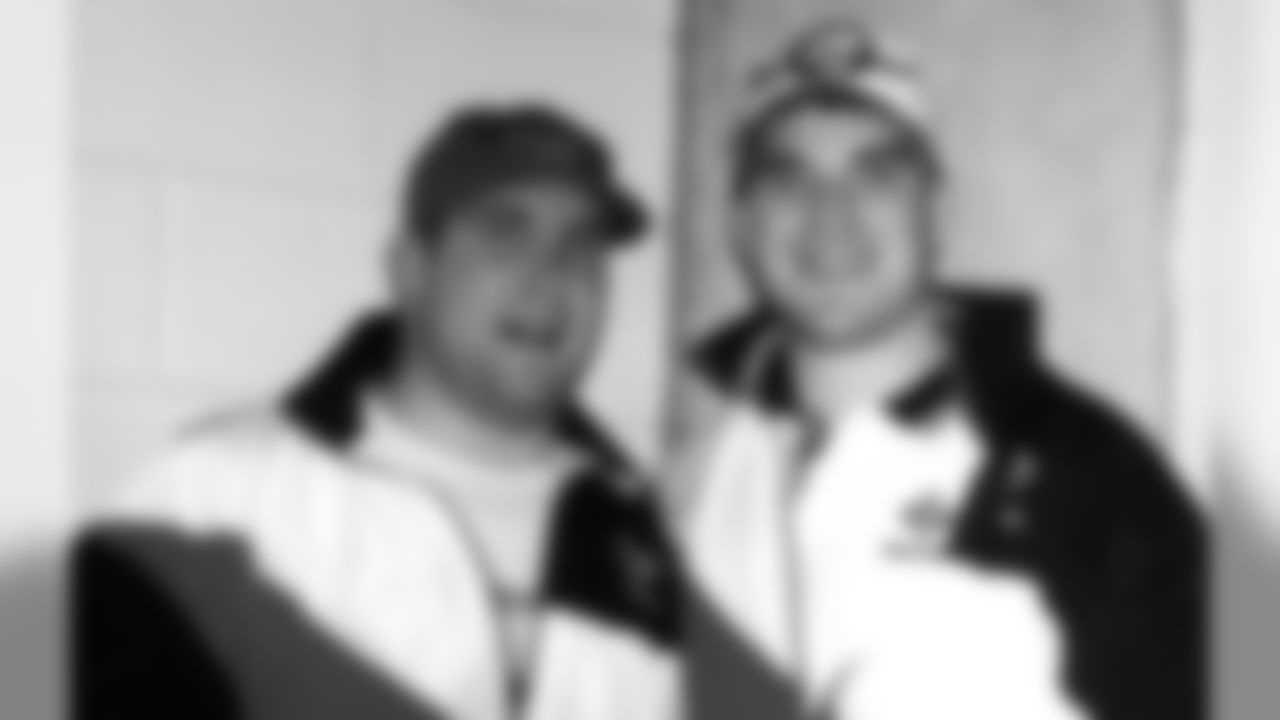This article was originally posted Nov. 18, 2014
How old Steve Keim exactly was when he made his declaration to his mother – the one where he insisted he was going to be an NFL general manager one day – is lost in the past, but he was a kid. Nine, maybe 10, not even playing tackle football yet.
He most certainly did tell Sally Keim that, though. She was careful to remind her son he needed to focus on his science and math in school as much as he studied football players. Yet such a promise wasn't surprising. When Steve's older sisters brought home male high school friends to the Keim house, Steve relished the chance talk football with them. There would be no tackle football until eighth grade – Mom didn't want him getting hurt – but there was always touch football in the neighborhood or requests at the front door for Dad when he got home from work to throw the football around.
Over the years, there were BMX races and dirt bikes, stints on a swim team, seasons spent playing soccer and basketball.
But for Steve Keim, "football was always his game," Sally Keim said.
He will downplay it now, but Steve Keim could play football. He started as an offensive lineman on the high school varsity team as a sophomore. He earned multiple scholarship offers, eventually heading to North Carolina State. He briefly got a chance in the NFL, although an ACL injury robbed him of what he might have become.
When his playing days ended soon after his college career, he still had his long-term goal. There would be dues to pay, a scouting life to lead. But even as he searched for a way into the NFL while working as the assistant strength coach at his alma mater – befriending a young defensive back named Adrian Wilson – Keim was driven to the future by his long-ago uttered promise.
"That's all he ever talked about," Wilson said. " 'I'm going to be a GM one day. I'm going to be a GM.' This is 1998; I didn't even know what a GM was. But I never doubted him or his drive to be where he is now."

Over 16 years in the NFL, Keim spent many of them constantly on the road, scouting for prospects. There is the search for the perfect combination of size, speed, strength.
"I am looking for the antithesis of Steve Keim," Keim said. "Guys that are long and athletic, not stubby, try-hard guys. I got the most out of my ability. I certainly hope I am a better general manager than I was a football player."
It wasn't as if Keim was a benchwarmer. Growing up in tiny Cumberland, Pennsylvania, football was king. Keim's parents started taking him to the local high school games by the time he was 2. Eventually the pickup games with friends morphed into stardom in high school, with Keim playing on the line on both sides of scrimmage, even working in a couple of touchdowns as a fullback.
His play allowed him to fulfill another promise he once made to his mother, the one where his parents wouldn't have to pay for college because he'd earn a scholarship. Schools like Rutgers, Syracuse, West Virginia and Pittsburgh recruited him, but the chance to go to Raleigh, North Carolina, and avoid the snow was all it took for a move south.
He was all-ACC as a junior as a guard, but when he tore his ACL in spring workouts before his senior year, it altered his path.
"He had a shot (at the NFL)," said William Hicks, the strength and conditioning coach at North Carolina State at the time. "After the injury, he wasn't quite the same player."
Anxious to play as a senior, Keim was back on the field that fall playing, gutting out his final college season and doing well enough to earn an offseason roster spot with the Miami Dolphins. It didn't last long. A stint with the CFL's Edmonton Eskimos ended when Keim wrecked his ACL a second time.
By then, Keim was already thinking ahead.
While playing at North Carolina State, Keim had already left an impression "as a football junkie," Hicks said. Keim knew all the players around the country. The coaching staff wanted to hire him as a general assistant; Hicks, who had grown close to Keim, happened to have an opening on the strength staff.
The setup was perfect. Keim could work with the team – he also helped coach the offensive line -- but he was also part of the gateway to the NFL. Many times it is the strength coaches that are a school's liaison to NFL scouts and personnel as they take looks at a school's players. That was Hicks' role, and Keim was able to make contacts trying to find a way into the league.
Rod Graves' title at the time was assistant to the president, in charge of running the Cardinals' scouting department. He had met Keim before, and Keim had spent time with Jerry Hardaway, the Cardinals' scout in the area covering North Carolina State. Hicks also knew Graves, having also worked with Graves' father, Jackie, when Jackie Graves was scouting. The relationships proved fruitful.
In 1999, the Cardinals hired Keim to be a regional scout in the East. It would lead to more than a decade of grueling months on the road, with room service, long flights and longer drives in rental cars. Keim eventually became director of college scouting, then director of player personnel, and then vice president of player personnel. Despite the grind, it was exactly what Keim wanted to be doing.
"I have not run across many scouts that have that kind of passion and love for evaluating players," said Graves, who was elevated to Cardinals' General Manager in 2007. "He had this energy about it. All he needed was to get experience."

Ken Keim worked as a machinist for Amped Electric for 42 years. A perfectionist, Ken taught his son that in addition to hard work, attention to detail is what mattered.
"It has paid huge dividends," Steve Keim said, "because along the way, when I wanted to quit something or take the easy way out, he always reminded me there are no shortcuts."
There was no easy path to the General Manager's office. Keim steadily rose through the ranks with the Cardinals, building a reputation as an up-and-coming personnel man who was going to end up as a GM. He became Graves' right-hand man for more than a decade, helping formulate many of the practices that have been used in the Cardinals' scouting department.
All along, Graves – who now is senior director of football operations for the New York Jets – believed Keim as GM would be a question of when, not if, and where.
He wasn't the only one. Buccaneers General Manager Jason Licht first met Keim when he was a scouting assistant with the Dolphins and Keim was on the Miami roster as a player. Licht, in fact, was the man who had to tell Keim he had been released.
The two stayed friendly over the years as competing scouts, but when Licht joined the Cardinals in 2008, the two became close friends as the team reached the Super Bowl. The friendship led Keim to push for Licht's return in 2012, after Licht had left to work for the Patriots.
"Steve knows how to push each person's individual buttons," Licht said. "He knows what gets people fired up, what gets people intimidated if they need to be intimidated. He knows how to pick people up when they are feeling down. It really is amazing."
Cardinals president Michael Bidwill decided to make wholesale changes at the end of the 2012 season following a 5-11 record. He fired both Graves and coach Ken Whisenhunt, and Keim was always a potential candidate to succeed Graves. Keim had interviewed for GM jobs a few times in previous years and was a hot candidate for the Jacksonville opening.
Bidwill said when Keim was hired that the more he talked to people "inside and outside" the facility, he realized Keim was the right choice to get the Cardinals' job. Even Graves, who remains close to the man he mentored, said he was happy when Keim got the job.
"I realize in our business you are always on the clock," Graves said. "It's just a matter of how long that clock extends. For me, I was able to accomplish quite a bit, some of which was recognized, some of which was not recognized, but it had come to a point where it was time to pass the baton. I could not have been more proud of the fact Michael chose Steve to do that.
"I just felt like Steve was the right person for the job. He knew the landscape there, he had the passion, he had the leadership skills to run a personnel department and to be a general manager. I could not have been more happy for Steve and the organization."
Keim was the GM for only a couple of months before arguably the toughest task he was ever going to have to make sat there in front of him. The team had decided Wilson, one of the faces of the franchise and a multi-year Pro Bowler, was no longer in the Cardinals' future plans.
The timing of the move dictated that Keim had to tell Wilson over the phone (the two were able to meet in person to discuss it further about a week later.) It was painful and emotional for both. Wilson believed he still had something left to give, and he had never left any doubt that he wanted to play his entire career in only a Cardinals' uniform. But the franchise wanted to move on.
Images of Cardinals GM Steve Keim through the years

GM Steve Keim visits with former safety Adrian Wilson at a 2014 practice

Keim and Cardinals president Michael Bidwill during Keim's introductory press conference as new GM

Keim congratulates Bruce Arians on Arians' first win as a Cardinals' head coach

Keim and Bruce Arians talk after a practice

A young Steve Keim

A high-school age Steve Keim with a buddy

Keim's high school graduation photo

Keim (left) during college

Keim lifts weights in college at North Carolina State

Guard Steve Keim at North Carolina State

Guard Steve Keim at North Carolina State

Keim attends the ceremony to retire Adrian Wilson's high school number in 2010

Keim and former Cardinals General Manager Rod Graves

Keim, Michael Bidwill and Bruce Arians after the first win of the Keim/Arians regime

Keim congratulates defensive end Calais Campbell after the Cardinals' 2013 win in Seattle

Keim talks with country music star Blake Shelton during a 2014 practice

Keim with father Ken and mother Sally

Keim at a training camp practice with comedian Frank Caliendo

Keim at the press conference for the contract extension for cornerback Patrick Peterson

Keim talks with Tyrann Mathieu at a 2014 training camp practice

The Cardinals' front office braintrust (from left): Michael Bidwill, Steve Keim, Mike Disner and Terry McDonough

Keim in the draft room with Bruce Arians and scouts
"It was his first tough decision," Wilson said. "There were no hard feelings, man. It's a business at the end of the day. He did a great job. That, to me, showed Arizona and the fans he has what it takes to be GM."
It was one of the first of what has turned into many roster moves – 387 total since Keim took over in January of 2013. The constant churning has been at the forefront of Keim's mentality, an internal promise to be proactive and aggressive with every decision.
He found a kindred spirit in Bruce Arians, the man Keim and Bidwill picked out of a host of candidates almost two years ago. The two have meshed well, with Keim figuring out the roster and Arians figuring out what to do with that roster.
"I could tell we'd get along great, and it was obvious he knew what he was doing," said Arians, who had never met Keim before the job interview. "There was an ease and respect factor right off the bat.
"The teams that have personnel departments and coaching staffs that don't take care of each other, they struggle. Ours, and everywhere I've been, where everyone is in it together, is the best way to be."
The first version of Keim's vision went 10-6. The second is atop the NFL standings at 9-1, with a three-game lead in the NFC West heading to Seattle this weekend. In some ways, trips to Seattle have defined Keim's path as a GM.

He was standing on the sideline in Seattle in 2012 during that awful 58-0 drubbing in which Keim promised himself it would never happen to the Cardinals again if he had anything to do about it. After he became GM, he smiled on the same sideline at the end of a 17-10 Cardinals win in 2013 – a victory that pierced the invincibility the Seahawks had at home, and pushed the Cardinals under Arians into full belief mode.
There is a constantly evolving three-year plan, with analytics and the salary cap crunched to see what makes the most sense for each signing. Keim will never escape his scouting roots though. While he can't go watch college players like he once did, the draft remains paramount to him.
"There is nobody harder on me than me," Keim said. "Now that the draft is so big and all the fans know all the players … it's great, because it shows enthusiasm for the draft and the league, but there are also a million armchair GMs out there and they all know the players. When you miss on players, that's how you get better and how you grow."
The young Keim was one of those guys who knew all the players. That perspective has matured, Wilson said, to make Keim the GM he is now.
"Over the years he's gotten better and better at noticing talent, knowing how to go straight to a guy's core to see if that's what they really, really want to do. If they really, really love football," Wilson said. "That's who he is. He's evolved into this guy who eats, sleeps and breathes football."
Keim, 42, might not be quite that locked in. Family time is important, as he and wife Kim have four young children who see Keim as Daddy and not the GM of the NFL's top team. Time with the kids, Keim said, help relieve the stress of the job.
But for Keim, the stress is worth it. He's doing the job he's wanted since he himself was a kid.
"When my feet hit the floor every morning, I have a smile," Keim said. "How many people can say they are living their dream?"















